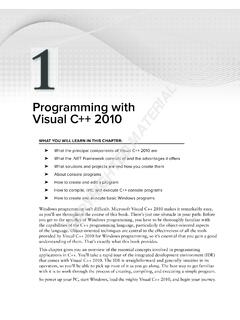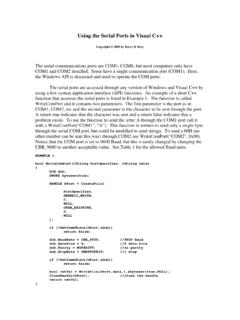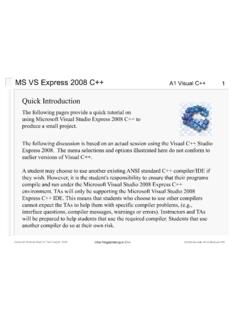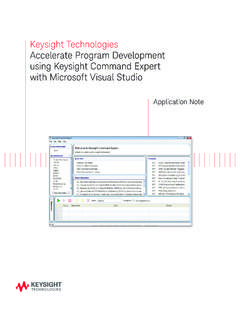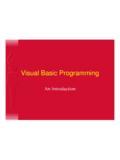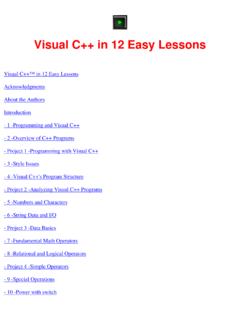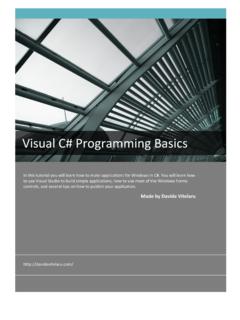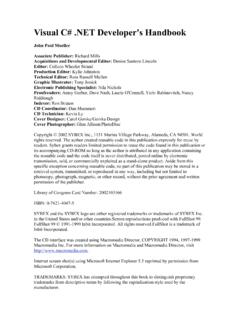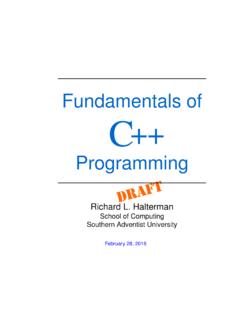Transcription of Audience - tutorialspoint.com
1 Microsoft Foundation Classes i About the Tutorial The Microsoft Foundation Class (MFC) library provides a set of functions, constants, data types, and classes to simplify creating applications for the Microsoft Windows operating systems. In this tutorial, you will learn all about how to start and create Windows-based applications using MFC. Audience This tutorial is designed for all those developers who are keen on developing best-in-class applications using MFC. The tutorial provides a hands-on approach with step-by-step program examples, source codes, and illustrations that will assist the developers to learn and put the acquired knowledge into practice. Prerequisites To gain advantage of this tutorial you need to be familiar with programming for Windows.
2 You also need to know the basics of programming in C++ and understand the fundamentals of object-oriented programming. Disclaimer & Copyright Copyright 2018 by Tutorials Point (I) Pvt. Ltd. All the content and graphics published in this e-book are the property of Tutorials Point (I) Pvt. Ltd. The user of this e-book is prohibited to reuse, retain, copy, distribute or republish any contents or a part of contents of this e-book in any manner without written consent of the publisher. We strive to update the contents of our website and tutorials as timely and as precisely as possible, however, the contents may contain inaccuracies or errors. Tutorials Point (I) Pvt. Ltd. provides no guarantee regarding the accuracy, timeliness or completeness of our website or its contents including this tutorial.
3 If you discover any errors on our website or in this tutorial, please notify us at Microsoft Foundation Classes ii Table of Contents About the Tutorial .. i i Prerequisites .. i Disclaimer & Copyright .. i Table of ii 1. MFC OVERVIEW .. 1 Prerequisites .. 1 What is MFC? .. 1 MFC Framework .. 1 Why MFC? .. 2 2. MFC ENVIRONMENT SETUP .. 3 3. MFC VC++ PROJECTS .. 8 4. MFC GETTING STARTED .. 9 Create Project Using Project Templates .. 9 Create Project from Scratch .. 14 5. MFC WINDOWS FUNDAMENTALS .. 19 Window Creation .. 24 Main Window .. 25 Windows Styles .. 27 Windows Location .. 29 Windows Size .. 30 Windows Dimensions .. 31 Windows Parents .. 32 Microsoft Foundation Classes iii 6. MFC DIALOG BOXES.
4 34 Dialog Box Creation .. 40 Dialog Location .. 43 Dialog Box Dimensions .. 45 Dialog Box 45 Modal Dialog Boxes .. 46 Dialog-Based Applications .. 49 7. MFC WINDOWS 58 Identifiers .. 59 Icons .. 60 Menus .. 63 Toolbars .. 68 Accelerators .. 75 8. MFC PROPERTY SHEETS .. 86 9. MFC WINDOWS LAYOUT .. 97 Adding controls .. 97 Control Grid .. 99 Controls Resizing .. 100 Controls Positions .. 101 Tab Ordering .. 107 10. MFC CONTROLS MANAGEMENT .. 111 Control Variable/Instance .. 111 Control Value Variable .. 116 Controls Event Handlers .. 118 Controls Management .. 121 Microsoft Foundation Classes iv 11. MFC WINDOWS CONTROLS .. 128 Static Control .. 128 Animation Control .. 128 Button .. 134 Bitmap Button .. 137 Command Button.
5 139 Static Text .. 142 List Box .. 144 Combo Boxes .. 152 Radio Buttons .. 157 Checkboxes .. 162 Image Lists .. 176 Edit Box .. 180 Rich Edit .. 185 Group Box .. 194 Spin Button .. 195 Managing the Updown Control .. 197 Progress Control .. 202 Progress Bars .. 206 Timer .. 209 Date & Time Picker .. 213 Picture .. 218 Image Editor .. 220 Slider Controls .. 223 Scrollbars .. 230 Tree Control .. 232 List Control .. 240 Microsoft Foundation Classes v 12. MFC MESSAGES AND EVENTS .. 249 Overview .. 249 Map of Messages .. 249 Windows Messages .. 253 Command Messages .. 259 Keyboard Messages .. 259 Mouse Messages .. 262 13. MFC ACTIVEX CONTROL .. 265 14. MFC - FILE SYSTEM .. 271 Drives .. 271 Directories .. 275 File Processing.
6 279 15. MFC STANDARD I/O .. 283 16. MFC DOCUMENT VIEW .. 289 View .. 289 Document .. 289 Frame .. 289 Single Document Interface (SDI) .. 289 Multiple Document Interface (MDI) .. 291 17. MFC - STRINGS .. 295 Create String .. 297 Empty String .. 298 String Concatenation .. 300 String 301 String Comparison .. 303 Microsoft Foundation Classes vi 18. MFC CARRAY .. 305 Create CArray Object .. 306 Add items .. 306 Retrieve Items .. 306 Add Items in the Middle .. 308 Update Item Value .. 310 Copy Array .. 312 Remove Items .. 314 19. MFC LINKED LISTS .. 317 Singly Linked List .. 317 Doubly Linked List .. 317 CList Class .. 318 Create CList Object .. 319 Add items .. 319 Retrieve Items .. 319 Add Items in the Middle.
7 321 Update Item Value .. 323 Remove Items .. 325 20. MFC DATABASE CLASSES .. 328 CDatabase .. 328 Insert Query .. 330 Retrieve Record .. 332 Update Record .. 337 Delete Record .. 341 21. MFC - SERIALIZATION .. 346 Microsoft Foundation Classes vii 22. MFC MULTITHREADING .. 353 23. MFC INTERNET PROGRAMMING .. 362 24. MFC - GDI .. 376 Drawing .. 376 Lines .. 382 Polylines .. 385 Rectangles .. 386 Squares .. 388 Pies .. 389 391 Chords .. 393 Colors .. 394 Fonts .. 396 Pens .. 398 Brushes .. 399 25. MFC LIBRARIES .. 402 Static Library .. 402 Dynamic Library .. 416 1 The Microsoft Foundation Class (MFC) library provides a set of functions, constants, data types, and classes to simplify creating applications for the Microsoft Windows operating systems.
8 In this tutorial, you will learn all about how to start and create windows based applications using MFC. Prerequisites We have assumed that you know the following: A little about programming for Windows. The basics of programming in C++. Understand the fundamentals of object-oriented programming. What is MFC? The Microsoft Foundation Class Library (MFC) is an "application framework" for programming in Microsoft Windows. MFC provides much of the code, which are required for the following: Managing Windows. Menus and dialog boxes. Performing basic input/output. Storing collections of data objects, etc. You can easily extend or override the basic functionality the MFC framework in you C++ applications by adding your application-specific code into MFC framework.
9 MFC Framework The MFC framework provides a set of reusable classes designed to simplify Windows programming. MFC provides classes for many basic objects, such as strings, files, and collections that are used in everyday programming. It also provides classes for common Windows APIs and data structures, such as windows, controls, and device contexts. The framework also provides a solid foundation for more advanced features, such as ActiveX and document view processing. In addition, MFC provides an application framework, including the classes that make up the application architecture hierarchy. 1. MFC Overview Microsoft Foundation Classes 2 Why MFC? The MFC framework is a powerful approach that lets you build upon the work of expert programmers for Windows.
10 MFC framework has the following advantages. It shortens development time. It makes code more portable. It also provides tremendous support without reducing programming freedom and flexibility. It gives easy access to "hard to program" user-interface elements and technologies. MFC simplifies database programming through Data Access Objects (DAO) and Open Database Connectivity (ODBC), and network programming through Windows Sockets. Microsoft Foundation Classes 3 Microsoft visual C++ is a programming environment used to create applications for the Microsoft Windows operating systems. To use MFC framework in your C++ application, you must have installed either Microsoft visual C++ or Microsoft visual Studio.










